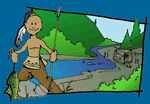


Geography and Landforms:
Alaska is by far the largest state in land area. If you placed it on top of the "lower 48," the Aleutian Islands would touch California's coast, the southeastern coast near Juneau would rest atop Georgia, and the North Slope would cover Minnesota. The population density of Alaska is only one person per 1.1 square miles.
|
 History:
The Russian discovery of Alaska in 1741 was the first introduction of Europeans to this unforgiving climate. Most of the people who traveled to Alaska from Russia were fur traders and whalers. They traded sea otter and other furs, and they set up a trading post and village on Kodiak Island in the late 1700s. For about twenty years the Russian- American company (owned by Russians) claimed exclusive rights to trade. Meanwhile, Captain Cook explored the coast, "discovering" Cook's Inlet where Anchorage is now.
|
 Economy:
Today, much of the money used to run the state of Alaska comes from the Trans-Alaska oil pipeline. When oil was discovered in Prudhoe Bay in 1968, it was not the first found in Alaska, but the quantity was astounding enough, and the demand for oil was high enough, to be worth building the pipeline, a project that took from 1974 to 1977. Construction of the pipeline brought many new people to Alaska. The workers were paid very well and given housing and food. Many more men than women came. Many of these new Alaskans decided to stay even after the pipeline was complete, having fallen in love with the natural beauty and outdoor recreation available.
|
 First Inhabitants:
The first native inhabitants of the area now known as Alaska probably migrated from Siberia, part of what is now Russia, at the end of the last ice age ten to twelve thousand years ago. Although experts are unsure whether they traveled a land bridge or by boat, archeologists have found signs of different native groups dating back thousands of years in Alaska.
|
Books Related To AlaskaBright Star, Bright Dawn - Scott O'Dell The Call of the Wild - Jack London Dancing at the Odinochka - Kirkpatrick Hill The Great Serum Race: Blazing the Iditarod Trail - Debbie Miller The Hungry Giant of the Tundra - Teri Sloat Julie - Jean Craighead George L is for Last Frontier: An Alaska Alphabet - Carol Crane Right Behind You - Gail Giles Water Sky - Jean Craighead George Wild Man Island - Will Hobbs The Year of Miss Agnes - Kirkpatrick Hill |
Famous Citizens:
|
| Capital: | Juneau |
| Entered Union: | January 3, 1959 |
| Population: | 736,732 |
| Area | 663,267 |
| Bird | Willow Ptarmigan |
| Flower | Forget Me Not |
| Nickname: | The Last Frontier, Land of the Midnight Sun |
| Governor | Bill Walker |
Places to Visit in Alaska: (Click the links to learn more.)
|



